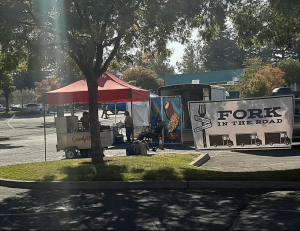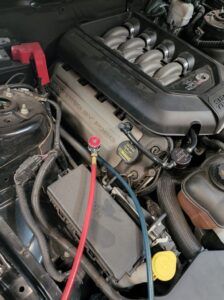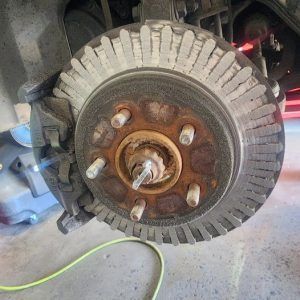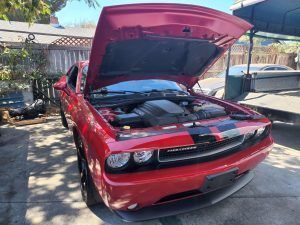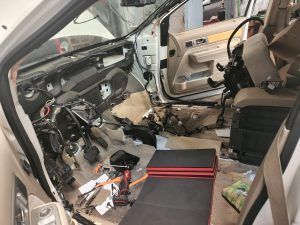How a Transfer Case in a Vehicle Works
A transfer case is an essential component in four-wheel-drive (4WD) and all-wheel-drive (AWD) vehicles. It plays a crucial role in distributing power from the engine to both the front and rear axles, enabling a vehicle to maintain traction and stability in various driving conditions. Understanding how a transfer case works can help you appreciate its importance in your vehicle’s drivetrain and the value of maintaining it properly, avoiding costly auto repair.
The Role of the Transfer Case in the Drivetrain
In most vehicles, power from the engine is directed to the transmission, which adjusts the speed and torque before transferring it to the wheels. In 2WD vehicles, this power is sent to either the front or rear axle. However, in 4WD and AWD systems, power needs to be distributed to both axles. The transfer case is responsible for this distribution, allowing the vehicle to maintain traction on slippery, uneven, or off-road surfaces.
The transfer case works alongside several key components:
- Transmission: Sends power to the transfer case.
- Driveshafts: Connect the transfer case to the front and rear axles.
- Differentials: Distribute power between the left and right wheels of each axle.
Types of Transfer Cases
Transfer cases come in different designs depending on the type of drivetrain system. The two main types are part-time and full-time transfer cases:
1. Part-Time Transfer Case
A part-time transfer case allows the driver to manually engage or disengage 4WD, typically using a lever, knob, or electronic switch. When in 2WD mode, power is sent only to the rear axle, which improves fuel efficiency. When 4WD is engaged, the transfer case splits power between the front and rear axles, providing enhanced traction.
Advantages:
- Better fuel economy in 2WD mode.
- Simpler design, often more durable.
Disadvantages:
- Requires driver input to switch modes.
- Not ideal for constant use on dry pavement, as it can cause driveline binding (a condition where wheels struggle to rotate at different speeds).
2. Full-Time Transfer Case
A full-time transfer case constantly sends power to all four wheels, with no need for manual engagement. These systems often use a center differential within the transfer case to manage the power split between the front and rear axles. Some models allow drivers to lock the center differential for improved off-road performance.
Advantages:
- Always engaged, providing continuous traction.
- Easier for everyday driving in various conditions.
Disadvantages:
- Slightly reduced fuel efficiency compared to part-time systems.
- More complex design, which can lead to higher repair costs.
Components of a Transfer Case
The transfer case is made up of several critical components that work together to transfer power effectively:
- Input Shaft: Receives power from the transmission.
- Output Shafts: Deliver power to the front and rear driveshafts.
- Chain or Gear Drive: Transfers power within the transfer case. Chain-driven systems are lighter and quieter, while gear-driven systems are stronger and more durable.
- Shift Mechanism: Allows the driver to change between different drive modes (2WD, 4WD High, 4WD Low).
- Differential (in full-time systems): Balances the power between the front and rear axles.
- Mode Selector (optional): Some transfer cases have a selector for different driving surfaces, like snow, mud, or sand, optimizing the power distribution for specific conditions.
Drive Modes Controlled by the Transfer Case
The transfer case provides different drive modes to suit various terrains and driving needs:
1. 2WD Mode (Two-Wheel Drive)
In this mode, the transfer case sends power only to one axle, typically the rear. This mode is used for everyday driving on paved roads where traction is not a concern.
2. 4WD High (Four-Wheel Drive High)
This mode splits power equally between the front and rear axles, suitable for driving at higher speeds on slippery surfaces like snow, mud, or gravel. It offers improved traction without sacrificing too much speed.
3. 4WD Low (Four-Wheel Drive Low)
In 4WD Low, the transfer case provides a lower gear ratio, delivering maximum torque to the wheels. This mode is ideal for slow-speed driving in extreme off-road conditions such as steep inclines, deep mud, or rocky terrain.
4. AWD Mode (All-Wheel Drive)
In AWD vehicles, the transfer case distributes power continuously to all four wheels without driver intervention. It adjusts the power distribution dynamically based on road conditions, providing optimal traction.
How a Transfer Case Works in Different Conditions
Normal Driving Conditions
In normal driving conditions on dry pavement, the transfer case in a part-time system remains disengaged, sending power only to the rear wheels. In full-time systems, the transfer case continuously manages power distribution, ensuring smooth handling and stability.
Slippery Conditions
When driving on slippery surfaces such as wet roads, snow, or mud, engaging the 4WD High mode ensures that power is distributed evenly to all four wheels, reducing the likelihood of losing traction. AWD systems automatically adjust the power distribution, offering seamless traction control without driver input.
Off-Road Conditions
In rugged off-road environments, 4WD Low mode is essential. The transfer case adjusts the gear ratio to increase torque, allowing the vehicle to handle steep inclines, deep mud, or uneven terrain with ease.
Importance of Transfer Case Maintenance
Proper maintenance of the transfer case is essential for ensuring its longevity and optimal performance. Key maintenance tasks include:
- Regular Fluid Changes: Transfer case fluid lubricates internal components and dissipates heat. Over time, this fluid can become contaminated or lose its effectiveness, leading to wear and tear. Most manufacturers recommend changing the fluid every 30,000 to 60,000 miles.
- Inspecting Seals and Gaskets: Leaking seals can lead to fluid loss, reducing lubrication and causing damage. Regular inspections help detect and fix leaks before they become serious.
- Checking for Unusual Noises or Vibration: Grinding, clunking, or vibration can indicate issues within the transfer case, such as worn gears or a failing chain.
Conclusion
The transfer case is a vital component of your vehicle’s drivetrain, ensuring proper power distribution to the front and rear axles for improved traction and stability in various driving conditions. Whether you’re navigating slippery roads or tackling challenging off-road terrain, a properly functioning transfer case enhances your vehicle’s performance and safety.
Regular maintenance and timely repairs are essential for keeping your transfer case in top condition. By understanding how the transfer case works and its importance in your vehicle’s drivetrain, you can ensure a smoother, safer driving experience, no matter the road conditions.
